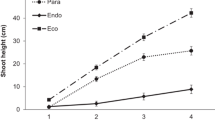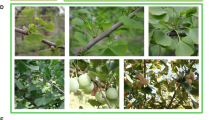Abstract
Cambium reactivation of temperate trees in spring is important for adaptation and growth. In some trees, the resumption of cambium cell division occurs before bud flush. However, knowledge about the source of the internal stimuli that promote cambium cell division during reactivation in these trees is limited. Here, the anatomical changes of cambium during reactivation along with the unfolding of vegetative buds in Populus tomentosa were examined under natural and water-culture conditions. Meanwhile, the levels of free indole-3-acetic acid (IAA) and transcripts of enzymes involved in its production were measured during cambium reactivation. The results showed that cambium cell division occurred before bud unfolding during cambium reactivation in P. tomentosa. Interestingly, the levels of IAA and the transcripts of poplar homologs of aldehyde oxidase 2 and nitrilases 2 encoding enzymes functioning in de novo IAA biosynthesis increased before bud unfolding, while the transcript levels of IAA conjugate hydrolases almost showed no increase. These results suggest that free IAA from de novo biosynthesis in cambium regions promotes cambium reactivation before bud unfolding, providing new insights into the regulatory mechanism of cambium reactivation.






Similar content being viewed by others
References
Antonova GF, Stasova VV (1997) Effects of environmental factors on wood formation in larch (Larix sibirica Ldb.) stems. Trees Struct Funct 11:462–468. doi:10.1007/PL00009687
Baba K, Karlberg A, Schmidt J, Schrader J, Hvidsten TR, Bako L, Bhalerao RP (2011) Activity–dormancy transition in the cambial meristem involves stage-specific modulation of auxin response in hybrid aspen. Proc Natl Acad Sci USA 108:3418–3423. doi:10.1073/pnas.1011506108
Bartel B, Fink GR (1995) ILR1, an amidohydrolase that releases active indole-3-acetic-acid from conjugates. Science 268:1745–1748. doi:10.1126/science.7792599
Bartel B, LeClere S, Magidin M, Zolman BK (2001) Inputs to the active indole-3-acetic acid pool: de novo synthesis, conjugate hydrolysis, and indole-3-butyric acid beta-oxidation. J Plant Growth Regul 20:198–216. doi:10.1007/s003440010025
Begum S, Nakaba S, Oribe Y, Kubo T, Funada R (2007) Induction of cambial reactivation by localized heating in a deciduous hardwood hybrid poplar (Populus sieboldii × P. grandidentata). Ann Bot 100:439–447. doi:10.1093/Aob/Mcm130
Begum S, Nakaba S, Oribe Y, Kubo T, Funada R (2010) Cambial sensitivity to rising temperatures by natural condition and artificial heating from late winter to early spring in the evergreen conifer Cryptomeria japonica. Trees Struct Funct 24:43–52. doi:10.1007/s00468-009-0377-1
Campanella JJ, Bakllamaja V, Restieri T, Vomacka M, Herron J, Patterson M, Shahtaheri S (2003a) Isolation of an ILR1 auxin conjugate hydrolase homolog from Arabidopsis suecica. Plant Growth Regul 39:175–181. doi:10.1023/A:1022528318188
Campanella JJ, Ludwig-Mueller J, Bakllamaja V, Sharma V, Cartier A (2003b) ILR1 and sILR1 IAA amidohydrolase homologs differ in expression pattern and substrate specificity. Plant Growth Regul 41:215–223. doi:10.1023/B:GROW.0000007501.27878.aa
Campanella JJ, Smith SM, Leibu D, Wexler S, Ludwig-Müller J (2008) The auxin conjugate hydrolase family of Medicago truncatula and their expression during the interaction with two symbionts. J Plant Growth Regul 27:26–38. doi:10.1007/s00344-007-9027-2
Campanella JJ, Sigethy S, Ludwig-Müller J (2011) Truncation of Medicago truncatula auxin conjugate hydrolases alters substrate specificity. Plant Mol Biol Rep 29:745–752. doi:10.1007/s11105-010-0266-1
Chen H, Wang T, Jin Y (1991) A study on GC–MS-SIM method for measuring content of IAA in plant tissue. J Beijing For Univ 13:56–61
Cui KM, Little CHA, Sundberg B (1992) The cambial activity and on which the effects of exogenous IAA in the stem of Pinus sylvestris L. Acta Bot Sin 34:515–522
Cui KM, Luo HL, Li JH, Li SW, Wei LB, Li ZL (1993) The resumption of cambial activity and the change of peroxidase isozymes in Broussonetia papyrifera. Acta Bot Sin 35:580–587
Davies RT, Goetz DH, Lasswell J, Anderson MN, Bartel B (1999) IAR3 encodes an auxin conjugate hydrolase from Arabidopsis. Plant Cell 11:365–376. doi:10.1105/tpc.11.3.365
Deslauriers A, Rossi S, Anfodillo T, Saracino A (2008) Cambial phenology, wood formation and temperature thresholds in two contrasting years at high altitude in southern Italy. Tree Physiol 28:863–871. doi:10.1093/treephys/28.6.863
Druart N, Johansson A, Baba K, Schrader J, Sjödin A, Bhalerao RR, Resman L, Trygg J, Moritz T, Bhalerao RP (2007) Environmental and hormonal regulation of the activity–dormancy cycle in the cambial meristem involves stage-specific modulation of transcriptional and metabolic networks. Plant J 50:557–573. doi:10.1111/j.1365-313X.2007.03077.x
Edlund A, Eklöf S, Sundberg B, Moritz T, Sandberg G (1995) A microscale technique for gas chromatography–mass spectrometry measurements of picogram amounts of indole-3-acetic-acid in plant-tissues. Plant Physiol 108:1043–1047
Frankenstein C, Eckstein D, Schmitt U (2005) The onset of cambium activity—a matter of agreement? Dendrochronologia 23:57–62. doi:10.1016/j.dendro.2005.07.007
Junghans U, Polle A, Düchting P, Weiler E, Kuhlman B, Gruber F, Teichmann T (2006) Adaptation to high salinity in poplar involves changes in xylem anatomy and auxin physiology. Plant Cell Environ 29:1519–1531. doi:10.1111/j.1365-3040.2006.01529.x
Lachaud S, Catesson AM, Bonnemain JL (1999) Structure and functions of the vascular cambium. Cr Acad Sci Iii-Vie 322:633–650. doi:10.1016/S0764-4469(99)80103-6
Larson PR (1994) The vascular cambium: development and structure. Springer, New York
LeClere S, Tellez R, Rampey RA, Matsuda SPT, Bartel B (2002) Characterization of a family of IAA-amino acid conjugate hydrolases from Arabidopsis. J Biol Chem 277:20446–20452. doi:10.1074/jbc.M111955200
Li WF, Cui KM, He XQ (2009a) Regulation of cell cycle regulators by environmental signals during growth–dormancy cycle of trees. Plant Signal Behav 4:959–961. doi:10.4161/psb.4.10.9642
Li WF, Ding Q, Chen JJ, Cui KM, He XQ (2009b) Induction of PtoCDKB and PtoCYCB transcription by temperature during cambium reactivation in Populus tomentosa Carr. J Exp Bot 60:2621–2630. doi:10.1093/jxb/erp108
Little CHA, Bonga JM (1974) Rest in cambium of Abies balsamea. Can J Bot 52:1723–1730. doi:10.1139/b74-224
Little CHA, Savidge RA (1987) The role of plant growth regulators in forest tree cambial growth. Plant Growth Regul 6:137–169. doi:10.1007/BF00043953
Ljung K, Bhalerao RP, Sandberg G (2001) Sites and homeostatic control of auxin biosynthesis in Arabidopsis during vegetative growth. Plant J 28:465–474. doi:10.1046/j.1365-313X.2001.01173.x
Ljung K, Hull AK, Kowalczyk M, Marchant A, Celenza J, Cohen JD, Sandberg G (2002) Biosynthesis, conjugation, catabolism and homeostasis of indole-3-acetic acid in Arabidopsis thaliana. Plant Mol Biol 50:309–332. doi:10.1023/A:1015298812300
Ludwig-Müller J (2011) Auxin conjugates: their role for plant development and in the evolution of land plants. J Exp Bot 62:1757–1773. doi:10.1093/jxb/erq412
Mano Y, Nemoto K, Suzuki M, Seki H, Fujii I, Muranaka T (2009) The AMI1 gene family: indole-3-acetamide hydrolase functions in auxin biosynthesis in plants. J Exp Bot 61:25–32. doi:10.1093/jxb/erp292
Matte Risopatron JP, Sun Y, Jones BJ (2010) The vascular cambium: molecular control of cellular structure. Protoplasma 247:145–161. doi:10.1007/s00709-010-0211-z
Michelot A, Simard S, Rathgeber C, Dufrêne E, Damesin C (2012) Comparing the intra-annual wood formation of three European species (Fagus sylvatica, Quercus petraea and Pinus sylvestris) as related to leaf phenology and non-structural carbohydrate dynamics. Tree Physiol 32:1033–1043. doi:10.1093/treephys/tps052
Mwange KN, Wang XW, Cui KM (2003) Mechanism of dormancy in the buds and cambium of Eucommia ulmoides. Acta Bot Sin 45:698–704
Mwange KN, Hou HW, Wang YQ, He XQ, Cui KM (2005) Opposite patterns in the annual distribution and time-course of endogenous abscisic acid and indole-3-acetic acid in relation to the periodicity of cambial activity in Eucommia ulmoides Oliv. J Exp Bot 56:1017–1028. doi:10.1093/jxb/eri095
Nilsson J, Karlberg A, Antti H, Lopez-Vernaza M, Mellerowicz E, Perrot-Rechenmann C, Sandberg G, Bhalerao RP (2008) Dissecting the molecular basis of the regulation of wood formation by auxin in hybrid aspen. Plant Cell 20:843–855. doi:10.1105/tpc.107.055798
Oladi R, Pourtahmasi K, Eckstein D, Bräuning A (2011) Seasonal dynamics of wood formation in Oriental beech (Fagus orientalis Lipsky) along an altitudinal gradient in the Hyrcanian forest, Iran. Trees Struct Funct 25:425–433. doi:10.1007/s00468-010-0517-7
Pang Y, Zhang J, Cao J, Yin SY, He XQ, Cui KM (2008) Phloem transdifferentiation from immature xylem cells during bark regeneration after girdling in Eucommia ulmoides Oliv. J Exp Bot 59:1341–1351. doi:10.1093/jxb/ern041
Rampey RA, LeClere S, Kowalczyk M, Ljung K, Sandberg G, Bartel B (2004) A family of auxin-conjugate hydrolases that contributes to free indole-3-acetic acid levels during Arabidopsis germination. Plant Physiol 135:978–988. doi:10.1104/pp.104.039677
Rosquete MR, Barbez E, Kleine-Vehn J (2012) Cellular auxin homeostasis: gatekeeping is housekeeping. Mol Plant 5:772–786. doi:10.1093/Mp/Ssr109
Rossi S, Rathgeber CBK, Deslauriers A (2009) Comparing needle and shoot phenology with xylem development on three conifer species in Italy. Ann Forest Sci 66:206. doi:10.1051/forest/2008088
Savić B, Tomić S, Magnus V, Gruden K, Barle K, Grenković R, Ludwig-Müller J, Salopek-Sondi B (2009) Auxin amidohydrolases from Brassica rapa cleave the alanine conjugate of indolepropionic acid as a preferable substrate: a biochemical and modeling approach. Plant Cell Physiol 50:1587–1599. doi:10.1093/Pcp/Pcp101
Schrader J, Baba K, May ST, Palme K, Bennett M, Bhalerao RP, Sandberg G (2003) Polar auxin transport in the wood-forming tissues of hybrid aspen is under simultaneous control of developmental and environmental signals. Proc Natl Acad Sci USA 100:10096–10101. doi:10.1073/pnas.1633693100
Schuller A, Ludwig-Müller J (2006) A family of auxin conjugate hydrolases from Brassica rapa: characterization and expression during clubroot disease. New Phytol 171:145–158. doi:10.1111/j.1469-8137.2006.01727.x
Sheldrake AR (1971) Auxin in the cambium and its differentiating derivatives. J Exp Bot 22:735–740. doi:10.1093/jxb/22.3.735
Singh ND, Venugopal N (2011) Cambial activity and annual rhythm of xylem production of Pinus kesiya Royle ex. Gordon (Pinaceae) in relation to phenology and climatic factors growing in sub-tropical wet forest of North East India. Flora 206:198–204. doi:10.1016/j.flora.2010.04.021
Strader LC, Bartel B (2011) Transport and metabolism of the endogenous auxin precursor indole-3-butyric acid. Mol Plant 4:477–486. doi:10.1093/Mp/Ssr006
Strader LC, Wheeler DL, Christensen SE, Berens JC, Cohen JD, Rampey RA, Bartel B (2011) Multiple facets of Arabidopsis seedling development require indole-3-butyric acid-derived auxin. Plant Cell 23:984–999. doi:10.1105/tpc.111.083071
Sundberg B, Little CHA (1990) Tracheid production in response to changes in the internal level of indole-3-acetic-acid in 1-year-old shoots of scots pine. Plant Physiol 94:1721–1727. doi:10.1104/pp.94.4.1721
Sundberg B, Uggla C (1998) Origin and dynamics of indoleacetic acid under polar transport in Pinus sylvestris. Physiol Plantarum 104:22–29. doi:10.1034/j.1399-3054.1998.1040104.x
Tuominen H, Sitbon F, Jacobsson C, Sandberg G, Olsson O, Sundberg B (1995) Altered growth and wood characteristics in transgenic hybrid aspen expressing Agrobacterium tumefaciens T-DNA indoleacetic-acid biosynthetic genes. Plant Physiol 109:1179–1189
Venugopal N, Liangkuwang MG (2007) Cambial activity and annual rhythm of xylem production of elephant apple tree (Dillenia indica Linn.) in relation to phenology and climatic factor growing in sub-tropical wet forest of northeast India. Trees Struct Funct 21:101–110. doi:10.1007/s00468-006-0101-3
Wang Q, Little CHA, Odén PC (1997) Control of longitudinal and cambial growth by gibberellins and indole-3-acetic acid in current-year shoots of Pinus sylvestris. Tree Physiol 17:715–721. doi:10.1093/treephys/17.11.715
Woodward AW, Bartel B (2005) Auxin: regulation, action, and interaction. Ann Bot 95:707–735. doi:10.1093/aob/mci083
Yang Y, Xu R, Ma CJ, Vlot AC, Klessig DF, Pichersky E (2008) Inactive methyl indole-3-acetic acid ester can be hydrolyzed and activated by several esterases belonging to the AtMES esterase family of Arabidopsis. Plant Physiol 147:1034–1045. doi:10.1104/pp.108.118224
Zhang YB, Zheng HM, Long RZ, Yang BC (1982) Seasonal cambial activity and formation of phloem and xylem in eight forest tree species grown in North China. Scientia Silvae Sinicae 18:366–379
Acknowledgments
This work was supported by the National Key Basic Research Program of China (2012CB114500) and the National Natural Science Foundation of China (31270219, 31200464). The authors thank Ms. Hua-Jun Chen and Wen-Hong Deng (Beijing Forestry University) for help in IAA measurement, Ms. Ai-Qin Song (Peking University) for statistical and image analysis, and Dr. IC Bruce (Zhejiang University) for critical reading of the manuscript.
Author information
Authors and Affiliations
Corresponding author
Additional information
Communicated by J. van Staden.
Rights and permissions
About this article
Cite this article
Li, WF., Ding, Q., Cui, KM. et al. Cambium reactivation independent of bud unfolding involves de novo IAA biosynthesis in cambium regions in Populus tomentosa Carr.. Acta Physiol Plant 35, 1827–1836 (2013). https://doi.org/10.1007/s11738-013-1220-2
Received:
Revised:
Accepted:
Published:
Issue Date:
DOI: https://doi.org/10.1007/s11738-013-1220-2




